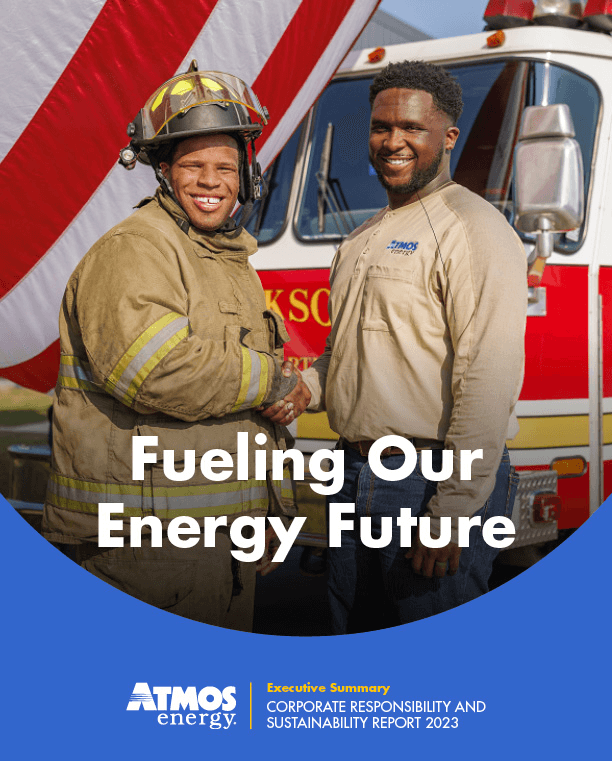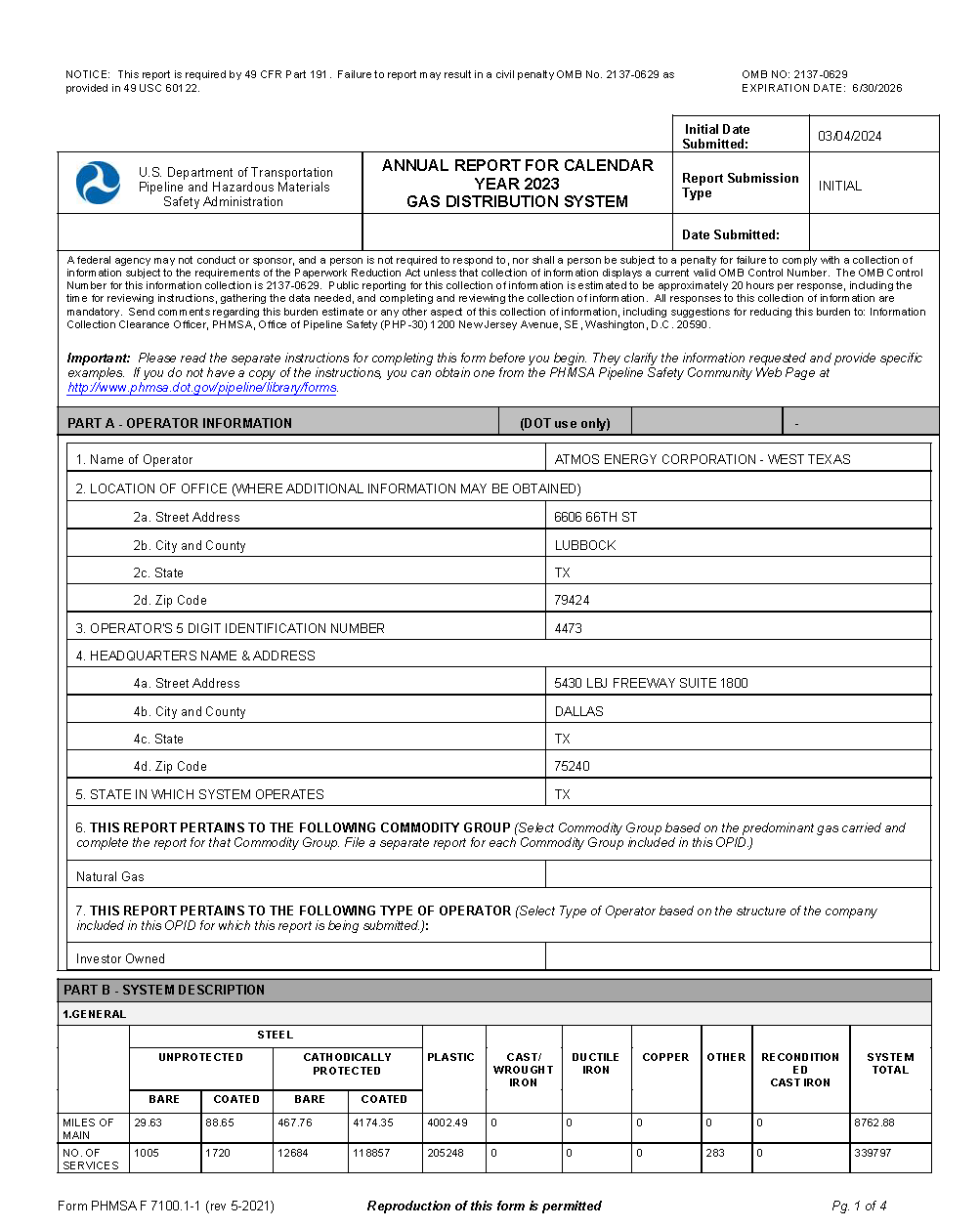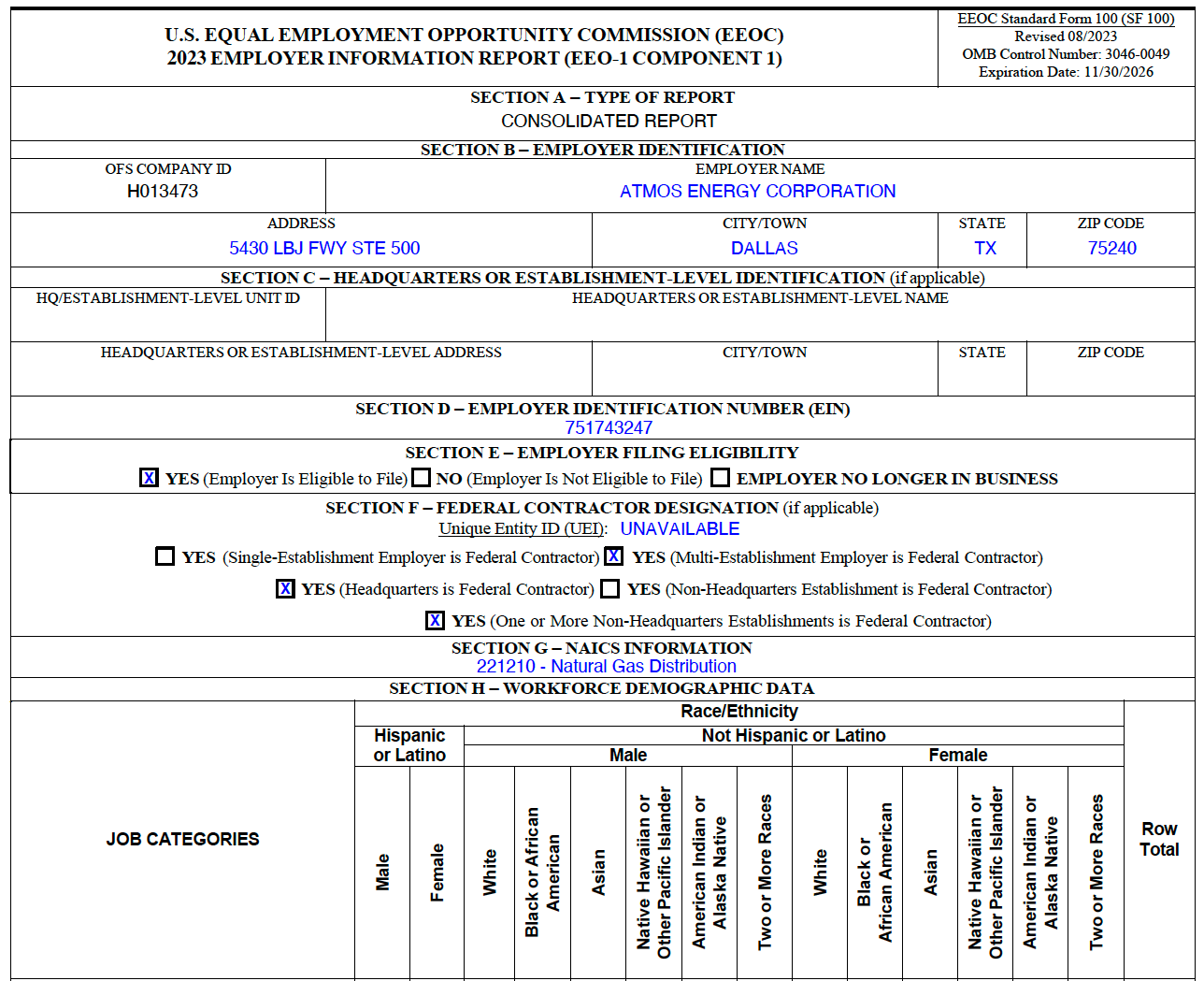We support the recommendations of the Task Force on Climate-Related Financial Disclosures (TCFD) and have committed to work toward implementation. Governance of this work is managed by the Corporate Responsibility, Sustainability, & Safety Committee of the Board of Directors (CRS&S) and is included in its Committee Charter. This committee also provides governance for the Company’s efforts for the broader ESG strategies and commitments. Atmos Energy's deliberate, integrated, enterprise-wide approach to TCFD recommendations underscores our commitment to meaningful implementation and continual improvement. We encourage you to read more about our Governance and Risk Management under the Corporate Governance heading. Additionally, we make disclosures based on the Sustainability Accounting Standards Board (SASB) and Global Reporting Initiative (GRI) frameworks and include relevant key performance indicators (KPIs) where possible. Atmos Energy has opted not to use the CDP framework because it is not tailored to the natural gas utility business. Each report section will include Atmos Energy’s overall approach to managing the topic, available performance data, recent highlights, and any forward-looking statements/goals that can be disclosed.
Executive Summary
2023 Sustainability Accounting Standards Board (SASB) Index
| Code | Accounting Metric | Location or Direct Response |
| IF-GU-000.A | Number of: (1) residential, (2) commercial, and (3) industrial customers served | Historical information is available in the Atmos Energy Corporation Statistical Summary, which is available on the Atmos Energy Website. |
| IF-GU-000.B | Amount of natural gas delivered to: (1) residential customers, (2) commercial customers, (3) industrial customers, and (4) transferred to a third party | Historical information is available in the Atmos Energy Corporation Statistical Summary, which is available on the Atmos Energy Website. |
| IF-GU-000.C | Length of gas (1) transmission and (2) distribution pipelines | At September 30, 2023, in our distribution segment, we owned an aggregate of 73,689 miles (118,591 km) of underground distribution and transmission mains throughout our distribution systems. These mains are located on easements or rights-of-way. We maintain our mains through a program of continuous inspection and repair and believe that our system of mains is in good condition. Through our pipeline and storage segment we owned approximately 5,645 miles (9,085 km) of gas transmission lines. 2023 Annual Report |
| IF-GU-240a.1 | Average retail gas rate for (1) residential, (2) commercial, (3) industrial customers, and (4) transportation services only | Historical information is available in the Atmos Energy Corporation Statistical Summary, which is available on the Atmos Energy Website. |
| IF-GU-240a.2 | Typical monthly gas bill for residential customers for (1) 50 MMBtu and (2) 100 MMBtu of gas delivered per year |
For residential customers using 50 MMBtu per year the average bill is $52.95 For residential customers using 100 MMBtu per year the average bill is $85.84 |
| IF-GU-240a.3 | Number of residential customer gas disconnections for non-payment, percentage reconnected within 30 days |
This is a metric that we do not publicly disclose. However, we proactively work with customers to provide them with solutions should they experience financial hardship. We are able to provide our customers with financial assistance should the need arise through programs like Sharing the Warmth and LiHEAP. More information about our Energy Assistance Programs can be found in Fueling Safe and Thriving Communities. |
| IF-GU-240a.4 | Discussion of impact of external factors on customer affordability of gas, including the economic conditions of the service territory | Atmos Energy’s natural gas bills are some of the lowest recurring household expenses for our customers and make up approximately 1% of the median income in the jurisdictions where we operate. We provide a comparison of our monthly gas bill in our monthly investor report along with providing a detailed chart of our bills historical growth and factors that impact customer bills. |
| IF-GU-420a.1 | Percentage of gas utility revenues from rate structures that (1) are decoupled or (2) contain a lost revenue adjustment mechanism (LRAM) | In our distribution segment, we have weather normalization of Weather Normalization Adjustment (WNA) mechanisms in all states, except for Colorado. This substantially mitigates the adverse effects of warmer-than-normal weather for meters in those service areas. We have one formal lost revenue adjustment mechanism called the DSM in Colorado. We also have formula rate mechanisms in place in four states that provide for an annual rate review and adjustment to rates. In our pipeline and storage segment, approximately 80% of this segment’s revenues are earned from delivery services to local distribution companies (including our MidTex Division) under a straight/fixed variable rate design. |
| IF-GU-420a.2 | Customer gas savings from efficiency measures by market |
Atmos Energy has active energy efficiency programs in the four states in which such programs have been approved by the state rate regulatory bodies. These programs provide measures to encourage reductions in energy consumption through more efficient natural gas appliances, improvements to the envelope of the home or business, and other measures that promote conservation. Annual reports are filed in each of the four states to reflect the gas savings achieved each year. For Colorado, see CUPC Proceeding No. 24AL-0212G. For Louisiana, see LPSC Docket No. U-36983. For Mississippi, see MPSC Docket No. 2014-UN-017. For the Mid-Tex Division, see the annual compliance filings of the Conservation and Energy Efficiency (“CEE”) Report in RCT GUD 10170. |
| IF-GU-540a.1 | Number of (1) reportable pipeline incidents, (2) Corrective Action Orders (CAO), and (3) Notices of Probable Violation (NOPV) | Reportable Pipeline Incidents (Defined as those reported pursuant to 49 C.F.R. 191.9 (Form 7100.1 Incident Reports) - 3 Corrective Action Orders (Defined as Corrective Action Orders issued pursuant to 49 C.F.R. 190.233) - 0 Notices of Probable Violations (Defined as a Notice of Probable Violation issued pursuant to 49 C.F.R. 190.207) - 0 |
| IF-GU-540a.2 | Percentage of distribution pipeline that is (1) cast and/or wrought iron and (2) unprotected steel | We publish this information in our DOT Annual Reports. Additionally the data is made available on our website, in our annual Corporate Responsibility and Sustainability Report and in our monthly Investor Updates. The 2023 Annual Reports reflect 0 miles of cast iron and 2,863.12 miles of unprotected steel, which represents approximately 3.9% of our distribution pipeline. |
| IF-GU-540a.3 | Percentage of gas (1) transmission and (2) distribution pipelines inspected |
In CY 2023, 995 miles transmission miles across the enterprise were inspected, which is approximately 15% of the 6,842 total transmission miles. Atmos Energy leak surveys the approximately 79,000 miles of our distribution and transmission pipelines at rates and frequencies that meet and often exceed state and federal guidelines. Monitoring frequency of pipelines is determined by federal and state pipeline safety regulations, accepted industry standards and internal Atmos Energy practices and procedures. |
| IF-GU-540a.4 | Description of efforts to manage the integrity of gas delivery infrastructure, including risks related to safety and emissions |
Atmos Energy is committed to being the safest provider of natural gas. That’s why we invested $2.8 billion in 2023 to modernize our pipeline infrastructure. Our system includes more than 79,000 miles of distribution and transmission pipelines, as well as smaller “service” pipelines that connect directly to homes and businesses. We bury much of our pipe underground, where it is away from weather and activities that commonly cause damage and leaks. Atmos Energy has always had processes and procedures in place to ensure the safety of our distribution and transmission network. During fiscal year 2023, we continued use of our Pipeline Safety Management System (PSMS), which formally documents our processes and procedures under a systematic and structured framework that builds on our established pipeline safety programs. PSMS was developed by the American Petroleum Institute and is a recommended practice for the pipeline industry. All Atmos Energy employees play a role in our PSMS through identification, prevention and remediation of operational safety risks. Additionally, because third party damage represents one of the greatest threats to distribution systems, Atmos Energy administers a Damage Prevention Ambassador Program that empowers team members to identify and prevent potential digging accidents in the field. In fiscal year 2023, ambassadors performed 68,000 stops and distributed more than 35,000 pieces of literature to excavators and home owners, helping to prevent many potentially dangerous and costly accidents. Additionally, we operate an emergency hotline 24 hours a day, 7 days a week to respond and investigate reports of natural gas leaks. Atmos Energy is committed to practices that reduce methane emissions from our transmission and distribution systems, including infrastructure renewal programs to replace aging steel and cast iron distribution pipelines. Atmos Energy utilizes a number of practices in its day-to-day operations to prevent or reduce methane emissions. Some of the practices include but are not limited to the following:
|
2023 Global Reporting Initiative (GRI) Index
General Disclosures
| GRI Indicator | Description | Location or Direct Answer |
|---|
| 2-1 |
|
| 2-2 |
|
| 2-3 |
|
| 2-4 |
|
| 2-5 |
|
| 2-6 |
|
| 2-7 |
|
| 2-9 |
| 2-10 |
|
| 2-11 |
|
| 2-13 |
|
| 2-14 |
|
| 2-15 |
|
| 2-16 |
|
| 2-17 |
|
| 2-18 |
|
| 2-19 |
|
| 2-20 |
|
| 2-21 |
|
| 2-22 |
|
| 2-23 |
|
| 2-24 |
|
| 2-25 |
|
| 2-26 |
|
| 2-27 |
|
| 2-28 |
|
| 2-29 |
|
| 2-30 |
|
Specific Disclosures
| GRI Standard | GRI Indicator | Description | Location or Direct Answer |
|---|
| GRI 201: Economic Performance 2016 |
|
| GRI 203: Indirect Economic Impacts 2016 |
|
| GRI 204: Procurement Practices 2016 |
|
| GRI 205: Anti-Corruption 2016 |
|
| GRI 206: Anti-Competitive Behavior 2016 |
|
| GRI 304: Biodiversity 2016 |
|
| GRI 305: Emissions 2016 |
|
| GRI 307: Environmental Compliance 2016 |
|
| GRI 401: Employment 2016 |
|
| GRI 403: Occupational Health and Safety 2018 |
|
| GRI 404: Training and Education 2016 |
|
| GRI 405: Diversity and Equal Opportunity 2016 |
|
| GRI 407: Freedom of Association and Collective Bargaining 2016 |
|
| GRI 411: Rights of Indigenous Peoples 2016 |
|
| GRI 412: Human Rights Assessment 2016 |
|
| GRI 413: Local Communities 2016 |
|
| GRI 417: Marketing and Labeling 2016 |
|
| GRI 418: Customer Privacy 2016 |
|
| GRI 419: Socioeconomic Compliance 2016 |
|
2023 DOT Report
2023 EEO-1 Report
List of Acronyms
Atmos Energy CRS Report Acronym List
- AEE—Atmos Energy Essentials
- AGA—American Gas Association
- AMLD—Advanced Mobile Leak Detection
- APT—Atmos Pipeline Texas
- Bcf—Billion Cubic Feet
- CEO—Chief Executive Officer
- CFR—Code of Federal Regulations
- CGI—Combustible Gas Indicator
- CH4—Methane
- CNG—Compressed Natural Gas
- CO2e—Carbon Dioxide Equivalent
- CRDS—Cavity Ring-Down Spectroscopy
- CRS—Corporate Responsibility and Sustainability
- CRS&S—Corporate Responsibility, Sustainability, and Safety
- CY—Calendar Year
- DART—Days Away/Restricted/Transfer Injury Rate
- DIM—Distribution Integrity Management
- DNG-SAC—Downstream Natural Gas Information Sharing and Analysis Center
- DOT—Department of Transportation
- EAPC—Employee Activity Planning Committee
- E-Bill—Electronic Billing
- EEO—Equal Employment Opportunity
- EPA—Environmental Protection Agency
- EPS—Earnings Per Share
- ESG—Environmental, Social, and Governance
- FBI—Federal Bureau of Investigation
- FID—Flame Ionization Detector
- FLC—Fort Lewis College
- FLIR—Forward Looking Infrared Camera
- FY—Fiscal Year
- GCI—Gas Cloud Imaging Camera
- GHG—Greenhouse Gas
- GPS—Global Positioning System
- GRI—Global Reporting Initiative
- HCA—High Consequence Area
- H-E-L-P—Determine Hazard, Determine Extent of Hazard, Protect Life, and Protect Property
- ICS—Incident Command System
- ILI—In-Line Inspection
- ISD—Independent School District
- ISN—ISNetworld
- KPI—Key Performance Indicator
- KTW—Keeping the Warmth Program
- LCRI—Low Carbon Resources Initiative
- LDC—Local Distribution Company
- LEED—Leadership in Energy and Environmental Design
- LIHEAP—Low Income Home Energy Assistance Program
- M&A—Mergers and Acquisitions
- MMcf—Million Cubic Feet
- MT—Metric Tons
- N2O—Nitrous Oxide
- NGSI—Natural Gas Sustainability Initiative
- NIST—National Institute of Standards and Technology
- NRCS—Natural Resources Conservation Service
- O&M—Operations and Maintenance
- OMD—Optical Methane Detector
- ONE Future—Our Nation’s Energy Future
- PHMSA—Pipeline and Hazardous Materials Safety Administration
- PIM—Pipeline Integrity Management
- PSMS—Pipeline Safety Management System
- RIR—Recordable Injury Rate
- RMCC—Risk Management and Compliance Committee
- RMLD—Remote Methane Leak Detection
- RMVC—Reportable Motor Vehicle Collision Rate
- RNG—Renewable Natural Gas
- RNG Coalition—Coalition for Renewable Natural Gas
- ROW—Right-of-Way
- SASB—Sustainability Accounting Standards Board
- SBA—Small Business Administration
- SMART—Sustainable Methane Abatement & Recycling Timeline
- SNAP—Supplemental Nutrition Assistance Program
- SOX—Sarbanes-Oxley Act of 2002
- SP4K—Snack Pak 4 Kids
- SUV—Sport Utility Vehicle
- U.S.—United States
- UGLD—Ultrasonic Gas Leak Detection
- WMR—Wireless Meter Reading
- ZEVAC—Zero Emissions Vacuum and Compressor
- ZNE—Zero Net Energy



